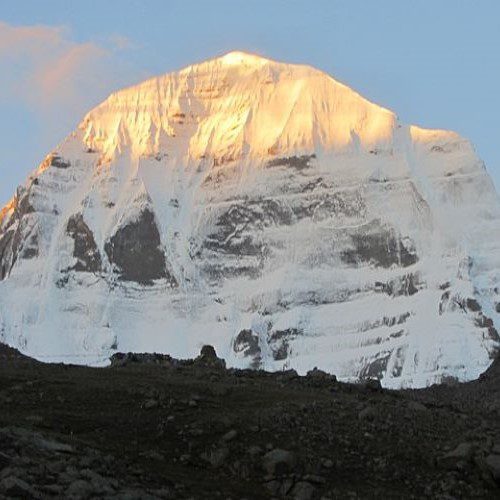Mount Kilimanjaro : Gateway to Heaven
At a glance
| Description | |
|---|---|
| Mythology | Chaga Mythology |
| Country | Tanzania |
| Closest airport | Kilimanjaro International Airport (JRO) |
| Type | Natural |
| Accessibility | 8/10 |
Introduction
Mount Kilimanjaro, Africa’s highest peak, is more than a towering natural wonder—it’s a place rich in mythology, cultural significance, and breathtaking beauty. Rising 5,895 meters above sea level, this dormant volcano in Tanzania has long captivated adventurers, storytellers, and spiritual seekers alike.
For the Chagga people, Kilimanjaro is not just a mountain but a sacred presence, home to ancestral spirits and deities. Its snow-capped summit, visible for miles, symbolizes strength and purity, while the mountain’s slopes support an astonishing variety of ecosystems, each with its own unique flora and fauna.
Whether scaling its heights for the challenge, immersing in its rich mythology, or simply marveling at its grandeur, Kilimanjaro offers an unforgettable experience. This legendary peak invites travelers to step into a world where nature, history, and spirituality converge in a truly remarkable way.
Connection with Mythology
For the Chagga people, Mount Kilimanjaro is more than a towering peak—it’s a sacred presence woven into their traditions. They believe the mountain was a divine gift from Mulungu, providing them with fertile land and protection. Some myths even speak of Kilimanjaro as a gateway to the underworld, guarded by the Wakonyingo, mystical dwarfs who punish those who disrespect its sanctity.
The spirits of Kilimanjaro play a crucial role in maintaining balance in the natural world. Local beliefs hold that honoring the mountain brings blessings, while neglecting it leads to misfortune. Among the many legends surrounding the peak is the tale of “Njaro,” a spirit said to test those who dare to climb, reinforcing the idea that Kilimanjaro is a threshold between the human and divine realms.
The mountain’s snow-capped summit has long been a source of wonder, inspiring myths that link it to the gods. Its rare tropical ice was seen as a symbol of purity, with some legends describing Kilimanjaro as a celestial bridge connecting mortals to higher powers. The mountain’s volcanic cones—Kibo, Mawenzi, and Shira—also hold deep cultural meaning, often viewed as manifestations of ancestral spirits or powerful natural forces that continue to shape the world.
Ways to Get There
Getting to Mount Kilimanjaro is a straightforward journey, with well-connected transport options for both international and domestic travelers. Most visitors fly into Kilimanjaro International Airport (JRO), located about 40 kilometers from the mountain. The airport receives flights from major cities worldwide, including direct or connecting routes through hubs like Nairobi, Amsterdam, and Doha. An alternative option is Julius Nyerere International Airport (DAR) in Dar es Salaam for those exploring more of Tanzania before heading to Kilimanjaro.
Upon arrival, travelers can reach the mountain’s gateway towns—Moshi and Arusha—via taxis, private transfers, or shuttle services. Moshi, being closer to the trailheads, is the preferred base for most climbers. From there, guided trekking tours handle logistics such as permits, porters, and experienced guides, ensuring a smooth ascent.
For those wanting to experience the region at their own pace, renting a car or using local transport offers opportunities to explore the surrounding villages and landscapes. Public buses provide an affordable alternative for budget-conscious travelers, making Kilimanjaro an accessible destination regardless of travel style.
What to Look For
Mount Kilimanjaro is more than just a towering peak; it’s a journey through breathtaking landscapes, shifting climates, and awe-inspiring sights. As climbers ascend, they pass through five distinct ecological zones, each with its own character. The lower slopes are covered in dense rainforests, where colobus monkeys swing between the trees and birds like sunbirds and hornbills fill the air with their calls. Higher up, the vegetation thins into moorlands dotted with giant lobelias before giving way to the stark beauty of the alpine desert, where the harsh environment supports only the hardiest forms of life. At the summit, glaciers glisten under the sun, a surreal sight so close to the equator, though these ice fields are sadly retreating due to climate change.
Beyond its natural beauty, Kilimanjaro holds deep cultural and historical significance. Along the trails, climbers encounter volcanic caves and striking rock formations that carry stories passed down through generations. Some of these landmarks are tied to local mythology, reinforcing the mountain’s spiritual role in the lives of the people who live in its shadow. The journey itself is often described as transformative, with each step bringing a new sense of accomplishment. The final push to Uhuru Peak, the highest point in Africa, is rewarded with a panoramic sunrise that paints the sky in shades of gold and pink, casting an unforgettable glow over the vast plains below. Whether admiring the landscapes, experiencing the local culture, or standing on the roof of Africa, Kilimanjaro offers a journey as profound as the destination itself.
Importance in cultural history
Mount Kilimanjaro is more than a towering peak; it is a cultural and historical emblem deeply ingrained in the identity of Tanzania and Africa. For centuries, it has inspired poets, artists, and leaders, symbolizing resilience, freedom, and unity. Its significance was solidified in Tanzania’s post-independence era, becoming a national emblem featured on the country’s coat of arms. The naming of its highest peak, Uhuru, meaning “freedom” in Swahili, reflects the spirit of independence from colonial rule.
For the Chagga people, who have lived on its slopes for generations, Kilimanjaro is not just a landmark but a way of life. They have developed advanced agricultural techniques such as terracing and irrigation to make use of the fertile volcanic soil, cultivating crops like coffee that contribute to their economic prosperity. Beyond sustenance, the mountain is deeply woven into their folklore, traditions, and spiritual beliefs. It is considered sacred, a place where rituals and offerings connect the living with their ancestors and the divine. Ruwa, the Chagga’s supreme deity associated with the sun and the mountain, plays a central role in their faith.
The history of Kilimanjaro is marked by clan wars, encounters with European missionaries, and the rise of nationalist movements, making it a stage for both local and national transformations. Today, the Chagga continue to share their knowledge and heritage as expert guides and porters, enriching the experience of climbers who seek to conquer its summit. The mountain’s global appeal extends into literature, most notably in Ernest Hemingway’s The Snows of Kilimanjaro, reinforcing its reputation as a symbol of perseverance, natural beauty, and cultural significance.
Best time to travel
Mount Kilimanjaro offers a year-round climbing experience, but the best times to trek are during the dry seasons: December to mid-March and late June to October. These periods provide clear skies, stable weather, and more comfortable trekking conditions. January and February are particularly favorable due to their warmer temperatures and excellent visibility, though they attract more climbers. Similarly, the July-to-September window offers excellent conditions, but it coincides with summer vacations in the Northern Hemisphere, leading to increased foot traffic.
For those seeking a quieter ascent, early December, late March, or June offer a balance of decent weather and fewer climbers. Some trekkers opt to climb during a full moon, which enhances visibility during the summit attempt and adds a breathtaking glow to the glaciers. However, Kilimanjaro’s weather remains unpredictable, with potential rain or snow at any time, making thorough preparation essential.
Beyond the physical challenge, Kilimanjaro embodies cultural and mythological significance. It is deeply interwoven with the traditions of the Chagga people and stands as a symbol of unity, resilience, and national pride. Whether drawn by the adventure of reaching the summit or the spiritual essence of the mountain, every climb is a transformative journey. As you ascend, respect its traditions, embrace its power, and savor the breathtaking beauty of Africa’s highest peak.
Source
User. (n.d.). Does Mount Kilimanjaro have any cultural significance? https://www.climbing-kilimanjaro.com/kilimanjaro-cultural-significance/
Ultimate Kilimanjaro. (2024). Is Kilimanjaro Evil? Home of Dieties, Spirits & Guardians. https://www.ultimatekilimanjaro.com/is-kilimanjaro-evil/
Myths and mysteries of Mount Kilimanjaro. (n.d.). http://www.just-kilimanjaro.com/?/blog/view/myths-and-mysteries-of-mount-kilimanjaro
The Story-tree | Chaga Tribe – Gateway Africa. (n.d.). https://www.gateway-africa.com/stories/The_Story_tree_Chaga.html
Frequently Asked Questions
Lorem ipsum dolor sit amet, consectetur adipiscing?
Lorem ipsum dolor sit amet, consectetur adipiscing elit. Praesent convallis vestibulum justo, ac tincidunt nunc vehicula quis. Nullam id dolor quis orci malesuada feugiat. Curabitur aliquet libero at urna ullamcorper, ac ultricies nulla dapibus.
Lorem ipsum dolor sit amet, consectetur adipiscing?
Lorem ipsum dolor sit amet, consectetur adipiscing elit. Praesent convallis vestibulum justo, ac tincidunt nunc vehicula quis. Nullam id dolor quis orci malesuada feugiat. Curabitur aliquet libero at urna ullamcorper, ac ultricies nulla dapibus.
Lorem ipsum dolor sit amet, consectetur adipiscing?
Lorem ipsum dolor sit amet, consectetur adipiscing elit. Praesent convallis vestibulum justo, ac tincidunt nunc vehicula quis. Nullam id dolor quis orci malesuada feugiat. Curabitur aliquet libero at urna ullamcorper, ac ultricies nulla dapibus.
Lorem ipsum dolor sit amet, consectetur adipiscing?
Lorem ipsum dolor sit amet, consectetur adipiscing elit. Praesent convallis vestibulum justo, ac tincidunt nunc vehicula quis. Nullam id dolor quis orci malesuada feugiat. Curabitur aliquet libero at urna ullamcorper, ac ultricies nulla dapibus.
Lorem ipsum dolor sit amet, consectetur adipiscing?
Lorem ipsum dolor sit amet, consectetur adipiscing elit. Praesent convallis vestibulum justo, ac tincidunt nunc vehicula quis. Nullam id dolor quis orci malesuada feugiat. Curabitur aliquet libero at urna ullamcorper, ac ultricies nulla dapibus.









